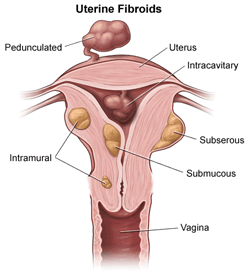
General Health Blog
Fibroids: All You Need To Know About It
Female health
Fibroids are noncancerous tumors that grow in the uterus. They may range from the size of a small marble, to the size of a lemon and in very rare and extreme situations, the size of a water melon.
Fibroids usually occur in women of childbearing age, in most cases between 30 and 40 years. Research have shown that about 80 percent of women would have them by the time they are 50 years old. Fibroids also tend to be more common among black women than women from other racial groups. No one knows why this is so, or even why fibroids form in the uterus.
The good news about this, is that a large percentage of women who have fibroids may not need treatment. Sometimes there are no signs and symptoms of fibroids, and they women may never know they even have fibroids. In such cases, the fibroid growth does shrink on its own especially during menopause. Also fibroids have no visible link to uterine cancers. In fact it is only in a few and rare cases do they become cancerous.
Other names for fibroids are; Leiomyoma, Myoma, Uterine myoma and fibromas.
Types of Fibroids
The different types of fibroids is as a result of the location it grew in or on the uterus.
Intramural fibroids: This type appear within the muscle walls of the uterus. They can grow large and expand the womb, even giving the appearance of pregnancy. It is by far the most common type.
Subserosal fibroids: These are the ones that grow on the outside of the womb. They sometimes grow large enough to show a bulge on the side of the abdomen.
Pedunculated fibroids: These are Subserosal growths that develop a stem, a slender base that supports the tumor.
Submucosal fibroids: These are the least common of all. They develop in the middle muscle layer, or myometrium, of the uterus.
Causes of Fibroids
The causes or reasons why these tumors develop on the uterus is still not quite clear. However, there are some factors that tend to aid their formation.
Hormones
The ovaries produce estrogen and progesterone at each menstrual cycle. These hormones stimulate the development of the uterine lining. And this process also seems to aid in the growth and development of fibroids.
Family History
Where fibroids happen to run in a family, females of that family are usually at risk of also developing fibroids.
Extracellular Matrix (ECM)
Picture what mortar does in a brick wall, that is what ECM does with cells. ECM is what makes cells stick together during development. In the presence of excessive ECM, the growth enlarges and grows stiff.
Risk Factors for Fibroids
Of course women of childbearing age are at risk, but there are other factors that may cause fibroids to develop.
Pregnancy: Pregnant women may be at risk of developing fibroids because of the increase in the production of estrogen and progesterone.
Heredity: You are at risk of developing fibroids if the women of your family have or had fibroids at one time.
Race: Black women seem to develop fibroids at a younger age. They tend to have larger fibroids and also more severe symptoms compared to women of other racial groups.
Obesity, alcohol consumption and a red meat high diet are also factors that favour these growths.
Symptoms of Fibroids
Heavy bleeding between or during your periods that includes blood clots.
Noticeable swelling of the abdomen.
Painful intercourse.
Increased urination.
Pains in the pelvis or lower back.
Longer lasting menstruation.
Trouble conceiving (usually with submucosal fibroids).
Increased menstrual cramping.
These are general symptoms of fibroids, however symptoms depends on a number of reason, such as number, sizes and location of the tumor.
And sometimes you won’t even notice any symptoms especially if your tumors are small, or you are going through menopause. They tend to shrink during menopause because the body produces less estrogen and progesterone which normally would stimulate the growth of fibroids.
Fibroids Diagnosis
A routine pelvic examination may be detected the presence of tumors . The pelvic exam usually lets the doctor know the size, shape and condition of the uterus. If the pelvic exam shows that the shape or condition of the uterus are not normal, other test may be run such as:
Ultrasound
The ultrasound takes pictures of the uterus by the use of sound waves. A transvaginal ultrasound may be used To get a better image of the uterus. This is so because the ultrasound wand is inserted into the vagina, as opposed to the normal ultra sound that takes pictures by simply placing it on the abdomen.
-

![Fibroids]()


Ultrasound Diagnosis -

![]()


Transvaginal Ultrasound Diagnosis
Pelvic MRI
The pelvic MRI (Magnetic Resonance Imaging) would be necessary if your doctor needs more information about the tumor. This is because the MRI tends to be more detailed than the ultrasound. Also in cases that the patient has a large uterus or is close to menopause the doctor tends to recommend MRI.
Hysteroscopy
Hysteroscopy involves the use of a small telescope with a light attached to it. This telescope is then inserted into your cervix. A saline solution is then injected into your uterine cavity to expand it, then the doctor can look at the walls of your uterus and fallopian tube openings, examining them for the presence of any growth.
Treatment of Fibroids.
The presence of fibroids does not necessarily mean you need treatment. They tend to grow slowly, and then begin to shrink during menopause. Fibroids usually becomes an issue when it begins to cause excessive bleeding, pains, bladder problems etc.
There are a couple of ways fibroids may be treated;
Natural Treatments and Supplements
Research studies on how natural herbal remedies can effect fibroids have been done with promising results. Some natural remedies include green tea and resveratrol rich supplements.
Green Tea
Green tea is rich in antioxidants as a results of flavanols contained in it. Antioxidants have been known to reduce cell damage as a result of free radicals and oxidative stress. A lot of disease can be traced to oxidative stress.
A research in 2013 was conducted on the effect of green tea extract on fibroids. The research involved 33 women. 11 of the women took a placebo, while 22 took the green tea extract. After 4 months, there was significant increase in the size of the tumors for those who took the placebo. However, for the ones who took the green tea extract, there was a significant reduction in size (about 30%) of the tumor.
Drinking green tea may therefore help with fibroids.
-

![Fibroids]()


Organo Gold Green Tea
Click here to order green tea online.
Resveratrol
Resveratrol is a chemical produced by Natural foods like blueberries, mulberries and grapes. It is also found in red wine.
Research suggest that resveratrol acts like an antioxidant. It protects the body against damage that can put you at higher risk for things like cancer. So it helps with cases of fibroids. Supplements rich in resveratrol is a good way to go.
Click here to order women’s health supplements online.
Medication
Birth control progesterone pills may help control and reduce heavy menstrual bleeding as a result of fibroids. However they do not shrink the growths.
Doctors may also prescribe Gonadotropin – releasing hormone agonist (GnRHa). These are drugs that shrink fibroids. However, you should know that these drugs do have side effects such as hot flashes, vaginal dryness, decreased libido, headache, fatigue, mood disturbances and decreased bone mineral density (bone loss).
For this reason, doctors don’t recommend that you take it for more than 6 months. Another drawback is that the fibroid often grows back.
Surgery
Surgery is recommended in cases where we have very large or multiple growths. This could either be an abdominal Myomectomy where a large incision is made on the abdomen and the fibroids are removed from the uterus. Or a Laparoscopy where a small incision is made and a camera with the surgical tools are inserted to get access to the uterus.
If the condition gets worse or possibly life threatening, a hysterectomy may be performed. This is the total removal of the womb. This means you will no longer be able to have children.
Other non-invasive procedures are;
Cryomyolysis to freeze the fibroids.
Myolysis procedure to shrink the tumor using electric currents or lasers.
Uterine artery embolization (UAE), where small particles are injected into the uterus in order to cut off blood supply to the fibroid.
Endometrial Ablation where a special instrument is inserted into the uterus. Using either heat, electric current, hot water or extreme cold, the uterine lining is destroyed the fibroid along with it.
Lifestyle Changes




Weight loss
Developing habits like, regular exercising, yoga, taichi etc to aid your loss weight may help. Clinical studies in china showed that obese and overweight people are at increased risk of developing fibroids. Fat cells tend to produce high amount of estrogen. Therefore, losing weight reduces estrogen and reduces size of fibroids.
Nutrition
The food you eat can hamper or help the development of fibroids.
Foods to avoid
Avoid or at least reduce eating excessive and simple refined carbohydrates like sugary foods and drinks like corn syrup. Also others like white rice, pasta, flour, crackers, baked foods.
You might also want to reduce or stop eating red meat. You may substitute it for white. Also consider stopping your alcohol intake.
Food to Eat
Foods to eat should include unprocessed fiber rich foods like barley, oatmeal, beans, and nuts. Milk and dairy products because they are rich in minerals you will need. Fruits and vegetables and finally vitamin rich foods.
In summary
It is a small percentage of fibroids that need treatment. If you are not having symptoms that affects your health and life chances are you would not need to treat the fibroids.
Except in the cases of submucosal fibroids which may prevent pregnancy, fibroids don’t cause problems during pregnancies. None the less, speak to your doctor if you have fibroids and expecting to become pregnant.
Research favours the use of natural remedies, supplements and change of lifestyle as one of the best approach to treating fibroids.
Click here to visit HEALTH-PLANET Natural Solutions online shop.








Leave a Reply
You must be logged in to post a comment.